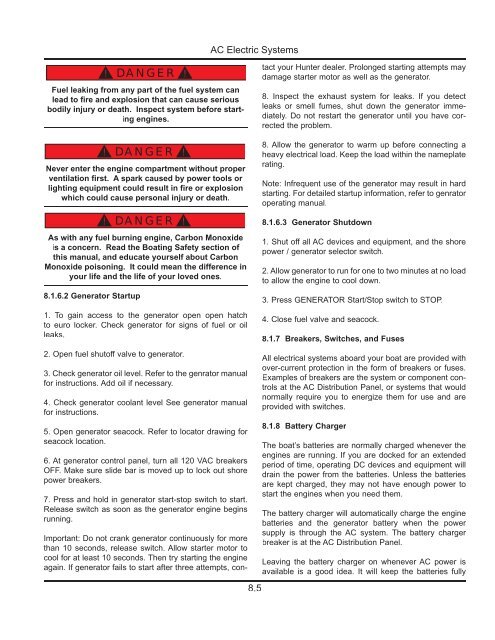36e Operator's Manual 2011.pdf - Marlow-Hunter, LLC
36e Operator's Manual 2011.pdf - Marlow-Hunter, LLC
36e Operator's Manual 2011.pdf - Marlow-Hunter, LLC
You also want an ePaper? Increase the reach of your titles
YUMPU automatically turns print PDFs into web optimized ePapers that Google loves.
AC Electric Systems<br />
! DANGER !<br />
Fuel leaking from any part of the fuel system can<br />
lead to fire and explosion that can cause serious<br />
bodily injury or death. Inspect system before starting<br />
engines.<br />
Important: Do not crank generator continuously for more<br />
than 10 seconds, release switch. Allow starter motor to<br />
cool for at least 10 seconds. Then try starting the engine<br />
again. If generator fails to start after three attempts, contact<br />
your <strong>Hunter</strong> dealer. Prolonged starting attempts may<br />
damage starter motor as well as the generator.<br />
8. Inspect the exhaust system for leaks. If you detect<br />
leaks or smell fumes, shut down the generator immediately.<br />
Do not restart the generator until you have corrected<br />
the problem.<br />
! DANGER !<br />
Never enter the engine compartment without proper<br />
ventilation first. A spark caused by power tools or<br />
lighting equipment could result in fire or explosion<br />
which could cause personal injury or death.<br />
! DANGER !<br />
As with any fuel burning engine, Carbon Monoxide<br />
is a concern. Read the Boating Safety section of<br />
this manual, and educate yourself about Carbon<br />
Monoxide poisoning. It could mean the difference in<br />
your life and the life of your loved ones.<br />
8.1.6.2 Generator Startup<br />
1. To gain access to the generator open open hatch<br />
to euro locker. Check generator for signs of fuel or oil<br />
leaks.<br />
2. Open fuel shutoff valve to generator.<br />
3. Check generator oil level. Refer to the genrator manual<br />
for instructions. Add oil if necessary.<br />
4. Check generator coolant level See generator manual<br />
for instructions.<br />
5. Open generator seacock. Refer to locator drawing for<br />
seacock location.<br />
6. At generator control panel, turn all 120 VAC breakers<br />
OFF. Make sure slide bar is moved up to lock out shore<br />
power breakers.<br />
7. Press and hold in generator start-stop switch to start.<br />
Release switch as soon as the generator engine begins<br />
running.<br />
8.5<br />
8. Allow the generator to warm up before connecting a<br />
heavy electrical load. Keep the load within the nameplate<br />
rating.<br />
Note: Infrequent use of the generator may result in hard<br />
starting. For detailed startup information, refer to genrator<br />
operating manual.<br />
8.1.6.3 Generator Shutdown<br />
1. Shut off all AC devices and equipment, and the shore<br />
power / generator selector switch.<br />
2. Allow generator to run for one to two minutes at no load<br />
to allow the engine to cool down.<br />
3. Press GENERATOR Start/Stop switch to STOP.<br />
4. Close fuel valve and seacock.<br />
8.1.7 Breakers, Switches, and Fuses<br />
All electrical systems aboard your boat are provided with<br />
over-current protection in the form of breakers or fuses.<br />
Examples of breakers are the system or component controls<br />
at the AC Distribution Panel, or systems that would<br />
normally require you to energize them for use and are<br />
provided with switches.<br />
8.1.8 Battery Charger<br />
The boat’s batteries are normally charged whenever the<br />
engines are running. If you are docked for an extended<br />
period of time, operating DC devices and equipment will<br />
drain the power from the batteries. Unless the batteries<br />
are kept charged, they may not have enough power to<br />
start the engines when you need them.<br />
The battery charger will automatically charge the engine<br />
batteries and the generator battery when the power<br />
supply is through the AC system. The battery charger<br />
breaker is at the AC Distribution Panel.<br />
Leaving the battery charger on whenever AC power is<br />
available is a good idea. It will keep the batteries fully

















